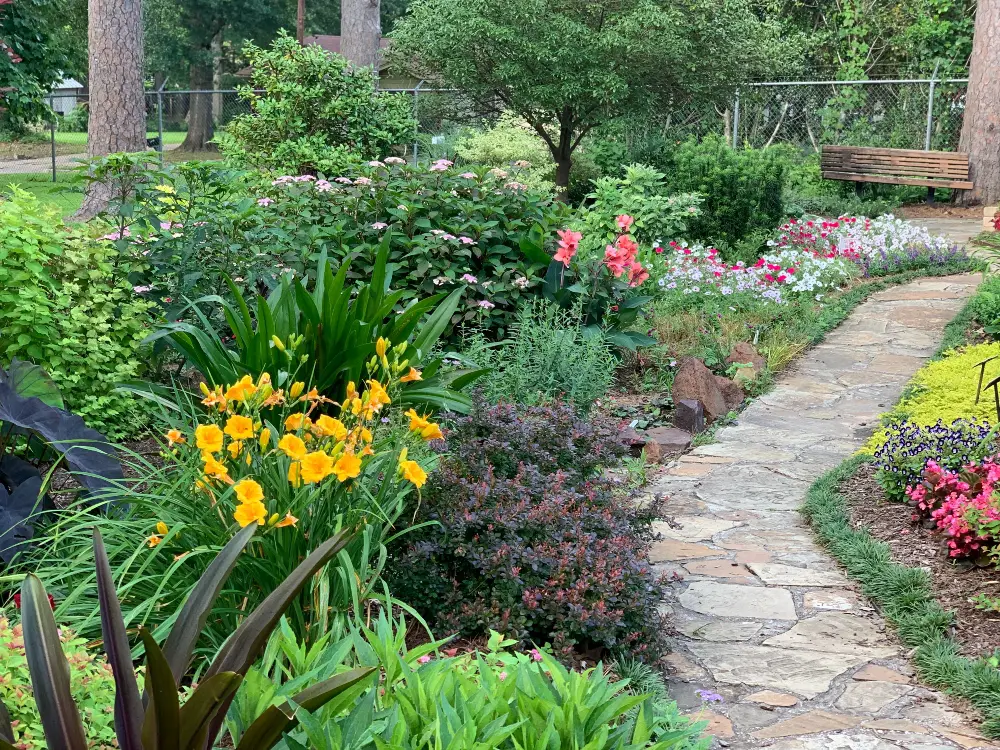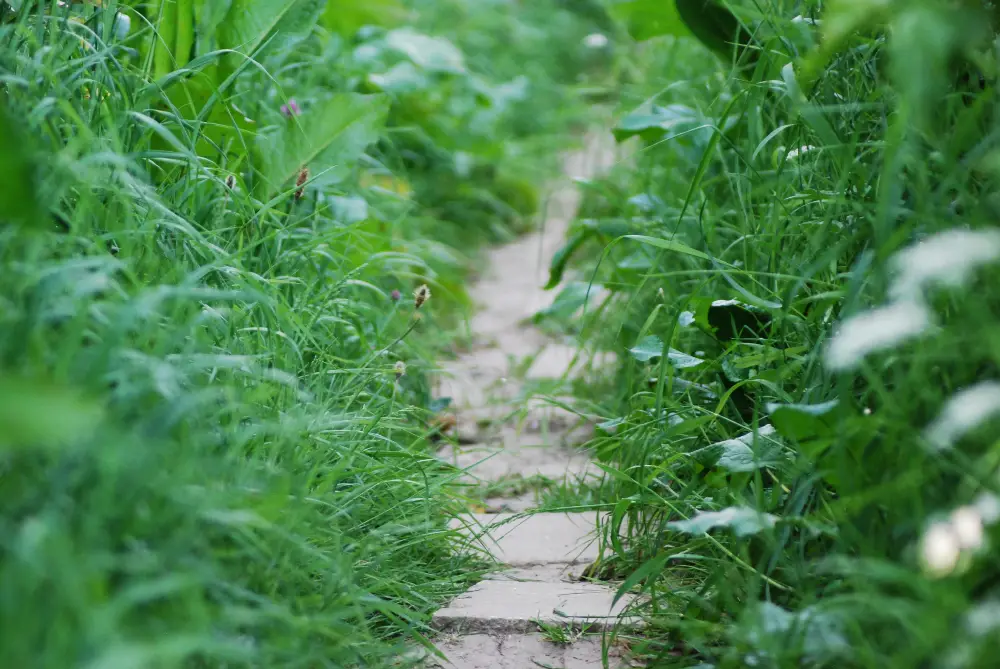Designing garden paths transforms a simple garden into a serene retreat. A well-designed path invites you to wander and explore, turning your garden into an oasis of tranquility. This guide will offer practical tips and design ideas. It will help you create garden paths that blend beauty and functionality.
Contents
The Importance of Garden Paths
Garden paths are more than just practical walkways; they are the soul of a garden’s design. They guide visitors through the landscape, drawing attention to focal points and creating a sense of discovery. Let’s explore why garden paths are vital to any garden.
Guiding the Journey
Garden paths serve as the guiding lines in a garden’s narrative. They influence how people move and interact with the space. By strategically placing garden paths, you can control the flow and focus of the garden experience. Whether leading to a hidden bench or a stunning flower display, garden paths ensure that every step taken is part of a deliberate journey.
Enhancing Aesthetic Appeal
The aesthetic value of garden paths cannot be overstated. They add structure and balance to the natural chaos of plants and flowers. Garden paths can be simple, like a gravel trail, or elaborate, like intricately patterned brickwork. Each type of path adds a unique character to the garden, enhancing its overall beauty.
Functional Benefits
Garden paths also have practical benefits. They protect your lawn and plants from being trampled, providing a safe route for visitors to travel. In wet conditions, garden paths prevent muddy footprints and make the garden accessible year-round. Properly designed garden paths also help with garden maintenance, making it easier to access all areas for upkeep.
Steps to Adding Garden Paths to Your Outdoor Space
Garden paths are a functional addition to your outdoor space that provides safety to everyone. It also creates a decorative aspect to your garden. Below are the steps to take when adding these DIY paths along your garden.
Planning Your Garden Path
When creating garden paths, careful planning is key. This section guides you through the initial steps. It helps ensure that your garden paths are not only beautiful but also functional and well-integrated into your landscape.
Assessing Your Garden’s Layout
Garden paths are the veins of a garden, vital for its design and functionality. When assessing your garden’s layout for garden paths, start with a bird’s-eye view. Map out the major components like your home, shed, water features, and existing vegetation. Identify natural traffic patterns and areas that could benefit from a direct route.
Consider the destinations within your garden. Garden paths should create a logical flow from one area to another, like from the patio to a gazebo or a flower garden. Use garden paths to highlight special features or hidden corners.
It’s also important to think about how garden paths will interact with different elements. For example, a path skirting around a pond creates a scenic route, while one that cuts through a lush flower bed can offer an immersive experience.
Respect the existing topography. Work with the land, not against it. If your garden is on a slope, winding garden paths can make the walk more comfortable and prevent erosion. In flat gardens, straight paths can create a sense of order and space.
Width and Direction Considerations
The width and direction of garden paths greatly influence the garden’s look and feel. Wider paths, typically ranging from four to six feet, are inviting and can comfortably accommodate two people walking side by side.
They’re ideal for main routes or social areas of the garden. Narrow paths, around two to three feet wide, are perfect for side or secret gardens. They give a more personal, intimate feel and are great for areas less frequented.
Direction plays a huge role in the garden’s ambiance. Straight paths offer a direct, formal approach, ideal for gardens with a strong architectural element. They create a sense of order and are easy to navigate.
Curved or winding paths, on the other hand, add an element of surprise and exploration. They’re perfect for casual, natural garden styles. Curves can also be used to direct sightlines away from unsightly areas or to create pleasant vistas.
When planning the direction, also consider the path’s orientation to the sun and prevailing winds. This can affect both the comfort of the path and the maintenance needs, like shading and drainage.

Design Elements of Garden Paths
Design elements are crucial in creating garden paths that are both functional and visually appealing. This section delves into how different design choices can impact the look and feel of your garden paths.
Integrating Curves and Straight Lines
The choice between curved and straight garden paths can dramatically alter your garden’s character. Curved paths offer a natural, organic look. They encourage strolls and create a sense of mystery about what’s around the bend. Curved garden paths are perfect for informal gardens. They can meander around trees, flower beds, or water features.
Straight garden paths, on the other hand, lend a sense of formality and order. They are ideal for gardens with a strong architectural element. Straight paths create a direct route from one point to another, making them practical for gardens that see a lot of foot traffic.
Balancing Soft Landscaping with Hard Materials
A harmonious balance between soft landscaping (like grass, plants, and shrubs) and hard materials (such as stone, brick, or concrete) is vital for garden paths. This balance ensures that the paths blend seamlessly with the rest of the garden.
For instance, a stone path lined with soft, flowering plants on either side can create a delightful contrast. Similarly, a grassy path with stepping stones offers a soft, natural feel.
Incorporating Lighting for Ambiance and Safety
Lighting along garden paths is not just a safety feature; it also adds ambiance. Soft, low-voltage lighting can highlight the path while creating a warm, inviting glow. Solar-powered lights are a sustainable option and can be used to accentuate key features along the path.
Consider lighting styles that complement your garden’s theme. For example, lantern-style lights can enhance a traditional garden, while sleek, modern fixtures work well in contemporary spaces.
Choosing the Right Materials
Selecting the proper materials is a critical step in designing garden paths. The material you choose not only defines the path’s appearance but also its durability and maintenance needs. Let’s explore the options for garden path materials.
Natural Stone
Natural stone is a popular choice for garden paths due to its durability and aesthetic appeal. It blends well with almost any garden style, from rustic to modern. Stone types like slate, limestone, and flagstone offer a range of colors and textures.
Natural stone can be more expensive and may require professional installation. However, its longevity and timeless look make it a worthwhile investment for many garden paths.
Pavers and Bricks
Pavers and bricks are versatile and come in various shapes, sizes, and colors. They are ideal for creating patterns and designs, adding a unique touch to garden paths. Pavers are relatively easy to install and can be replaced individually if damaged. Bricks offer a classic, timeless look but may require more maintenance to prevent moss and weed growth.

Gravel and Pebbles
Gravel and pebbles are cost-effective options for garden paths. They provide a natural, informal look and are excellent for drainage. However, they can shift over time and may need regular topping up. Also, consider accessibility, as gravel paths may not be suitable for wheelchairs or strollers.
Wooden Boards and Mulch
Wooden boards, such as decking, create a warm, natural path. They are especially suitable for damp areas or where a raised path is needed. Mulch is another organic option that’s gentle on the feet and blends seamlessly with the garden. Both materials, however, require regular maintenance and can be prone to rot in very damp conditions.
Concrete and Resin-Bound Surfaces
Concrete garden paths are durable and can be colored or textured to suit different garden styles. Resin-bound surfaces combine the durability of concrete with the aesthetic flexibility of gravel, offering a smooth, permeable surface. Both options require professional installation but provide long-lasting, low-maintenance garden paths.
Rubber Mulch
Rubber mulch is a unique and eco-friendly option. Made from recycled tires, it’s soft underfoot and offers excellent shock absorption. This makes it a great choice for paths in gardens where children play. It’s also durable and requires little maintenance. However, it’s essential to ensure the rubber is free from harmful chemicals.
Crushed Stone or Decomposed Granite
Crushed stone or decomposed granite provides a more stable surface than loose gravel. These materials create a rustic, natural-looking path that blends well with xeriscapes or rock gardens. They also allow for good drainage and are relatively easy to maintain.
Bark Chips
Bark chips offer a soft and natural path material that can complement a woodland garden or a rustic landscape. They’re inexpensive and can be easily spread. Over time, bark chips will decompose and need to be replenished, but they add valuable organic matter to the soil.
Artificial Grass
For a low-maintenance, green option year-round, consider artificial grass. It’s particularly useful in areas where natural grass struggles to grow. Artificial grass paths can be cut to any shape and size, offering versatility in design. They require no watering or mowing, although they may need occasional cleaning.
Cobblestones
Cobblestones are an excellent choice for creating a timeless, classic look. They are incredibly durable and can handle heavy foot traffic. Cobblestones add a charming old-world feel to garden paths but can be uneven underfoot and may require professional installation.
Glass Pebbles
For a more contemporary and decorative approach, consider using glass pebbles. They come in various colors and can create a stunning visual effect, especially when combined with lighting. Glass pebbles are best used in low-traffic areas of the garden and can be mixed with other materials for a unique path design.

Plant Integration Along Garden Paths
Adding plants along garden paths is essential for creating a cohesive and inviting landscape. The right plants can enhance the beauty of garden paths, making them feel like a natural part of the garden. Let’s explore how to select and maintain plants that complement your garden paths.
Selecting Plants for Your Path
Choosing plants for your garden paths involves considering several factors. Look for plants that match the style of your garden and the material of the path. Low-growing ground covers are ideal for softer, natural paths like mulch or gravel. For more structured paths, like those made of pavers or stone, consider border plants that add height and structure.
Think about the amount of foot traffic and sunlight your garden paths receive. Plants along frequently used paths should be hardy and able to withstand occasional brushing or stepping. For sunny paths, choose drought-resistant plants. For shaded paths, opt for shade-loving varieties.
Creating Visual Interest
Varying the height and texture of plants along garden paths adds visual interest. Taller plants can create a sense of enclosure and privacy, while shorter ones can highlight the path’s shape and direction. Use flowering plants to add pops of color. Evergreens can provide year-round structure and color.
Consider the bloom times of your plants. Aim for a succession of blooms to ensure that your garden paths are surrounded by color and interest throughout the growing season.
Maintenance Tips
Maintaining the plants along your garden paths is crucial. Regular pruning and deadheading will keep the plants healthy and prevent them from overgrowing the path. Mulching around the plants helps retain moisture and suppress weeds. If using aggressive spreaders, be prepared to trim them back to keep your garden paths clear.
DIY Tips for Building Garden Paths
Creating garden paths can be a unique DIY adventure. Let’s explore some innovative tips that will make your garden paths stand out and ensure your project is both enjoyable and successful.
Utilizing Unique Patterns and Shapes
When laying out garden paths, consider going beyond straight lines. Experiment with unique patterns or shapes. You could create a spiral pattern, a zigzag path, or even incorporate circular areas that serve as small patios or rest spots. Use different colored stones or pavers to create interesting designs or mosaics within your garden paths.
Incorporating Functional Elements
As you design your garden paths, think about adding functional elements. This could be a built-in bench along the path, a small bridge over a garden pond, or stepping stones that lead to a hidden garden nook. These elements make your garden paths more than just walkways; they become interactive experiences.
Using Recycled Materials
Consider using recycled materials for a unique and eco-friendly approach. Old bricks, broken tiles, or reclaimed wood can add character to your garden paths. These materials not only save costs but also contribute to a sustainable garden design.
Creating a Living Path
For a truly unique garden path, consider a living path. This involves planting hardy ground cover plants, like thyme or chamomile, between pavers or stepping stones. As these plants grow, they create a lush, living walkway that smells wonderful when walked upon.
Lighting for Nighttime Beauty
Strategically placed lighting can transform your garden paths after dark. Solar-powered LED lights are a great choice for their ease of installation and sustainability. You can place them along the edges of the path or hang them from nearby trees for a magical evening effect.
Adding a Water Feature
Incorporate a small water feature alongside or even within your garden paths. A simple fountain or a shallow water channel can add a soothing element. The sound of water adds tranquility and can attract wildlife to your garden.
Personalizing with DIY Art
Finally, personalize your garden paths with DIY art. This could be hand-painted stones, homemade sculptures, or mosaic art created from broken ceramics. These personal touches will make your garden paths uniquely yours.
Maintaining Your Garden Paths
Regular maintenance is key to keeping your garden paths beautiful and functional. Proper care will extend their lifespan and preserve their appearance. Here’s how to maintain different types of garden paths.

Regular Cleaning
All garden paths benefit from regular cleaning. Sweep off leaves, debris, and dirt to prevent staining and deterioration. For paved or stone paths, occasional washing with a hose or pressure washer can remove dirt buildup. For gravel or mulch paths, raking will keep the surface level and tidy.
Weed Control
Weed control is essential for outdoor paths. Regularly check for and remove any weeds. For paved paths, use a natural weed killer or boiling water to treat weeds growing in the cracks. For gravel and mulch paths, a weed barrier fabric can be helpful.
Repair and Replenishment
Inspect your outdoor paths regularly for any damage. Loose or broken pavers should be reset or replaced. For gravel and mulch paths, add more material as needed to keep the path well-covered and even.
Managing Erosion
Erosion can be a challenge, especially for outdoor paths on slopes. Add edging to your paths to keep materials in place. For severe erosion issues, consider installing drainage solutions like French drains.
Seasonal Maintenance
Seasonal changes can affect outdoor paths. In winter, ensure paths are clear of snow and ice for safety. In autumn, clear fallen leaves to prevent slippery surfaces and mold growth.
Sealing and Protecting
For certain materials like wood or some types of stone, applying a sealant can protect against weather and wear. Check the manufacturer’s recommendations and reapply the sealant as needed.
FAQ for Designing Serene Garden Paths
What is the ideal width for a garden path?
The ideal width depends on the path’s use. For main garden paths, 3 to 4 feet is standard to allow two people to walk side by side comfortably. For secondary paths, 2 feet is usually sufficient.
Can I build garden paths on a slope?
Yes, you can build paths on a slope. The key is to use materials that provide good traction and consider building steps or using a winding design to make the slope more manageable.
What are the best low-maintenance materials for outdoor paths?
Pavers, bricks, and natural stone are great low-maintenance options. They require minimal upkeep and are durable. Mulch and gravel might need more frequent replenishment.
How can I make my garden paths wheelchair accessible?
For wheelchair accessibility, ensure the path is at least 3 feet wide and has a firm, smooth surface. Avoid materials like gravel that can be difficult to navigate in a wheelchair.
What are some cost-effective materials for outdoor paths?
Gravel, mulch, and recycled materials like reclaimed bricks or stones are cost-effective options. They are readily available and easy to work with.
How do I prevent weeds from growing on my garden paths?
Using a weed barrier fabric under loose materials like gravel can help prevent weed growth. Regular maintenance and spot treatments with natural weed killers can also be effective.
Can outdoor paths be environmentally friendly?
Absolutely. Using permeable materials like gravel or certain types of pavers allows water to seep through, reducing runoff. Recycled materials are also an eco-friendly choice.
How often should outdoor paths be maintained?
Maintenance frequency depends on the material. Some paths may need annual check-ups for loose pavers or replenishment of materials like gravel, while others may require less frequent care.
What plants are best suited for planting along garden paths?
Low-growing, hardy plants that can tolerate foot traffic are ideal. Consider ground covers like creeping thyme or low-maintenance shrubs and perennials that complement your garden’s aesthetic.
Can I add lighting to my garden paths?
Yes, adding lighting can enhance both the beauty and safety of outdoor paths. Solar lights are a popular choice as they are easy to install and eco-friendly.
Conclusion
Designing and installing garden paths is an enriching journey that enhances the beauty and functionality of your outdoor space. By considering the right materials, integrating plants, and employing innovative DIY tips, you can transform your garden into a delightful sanctuary.






